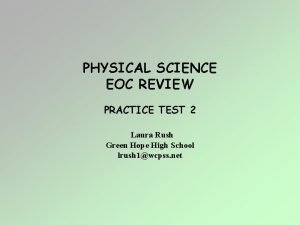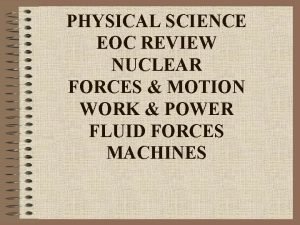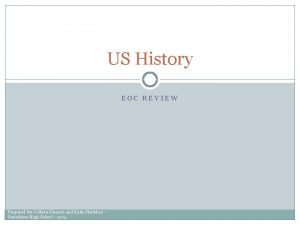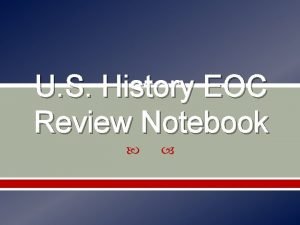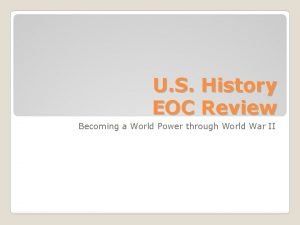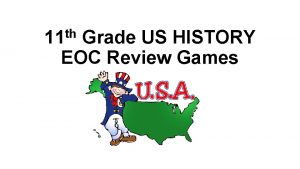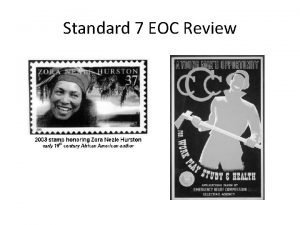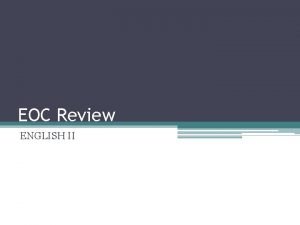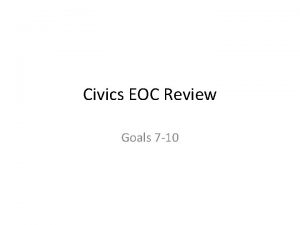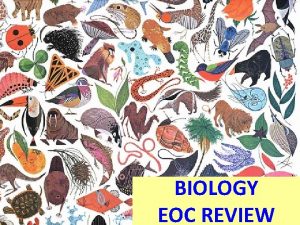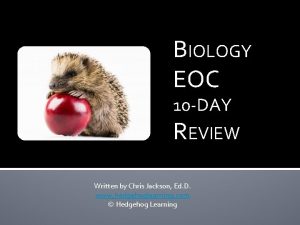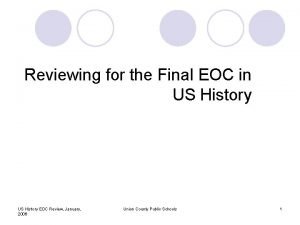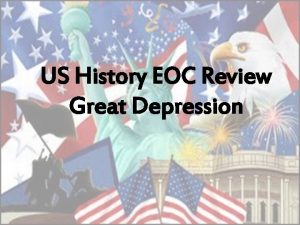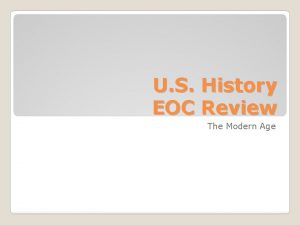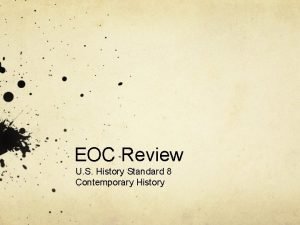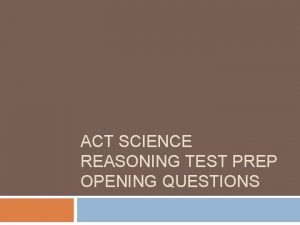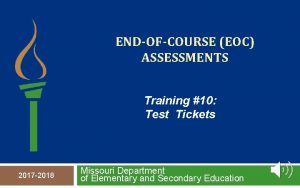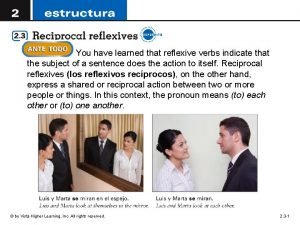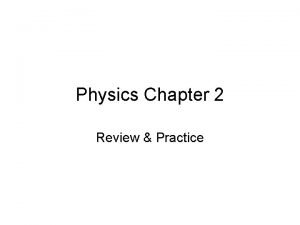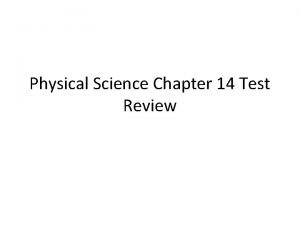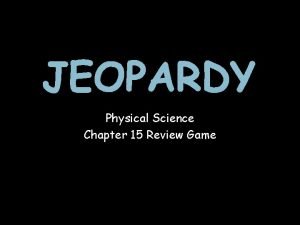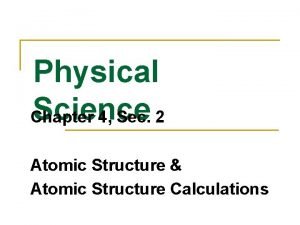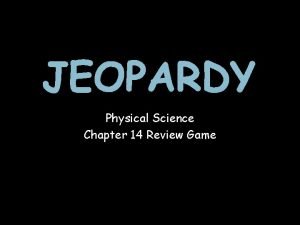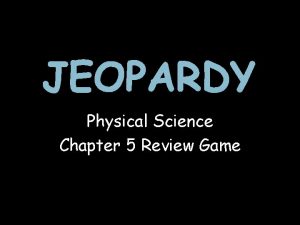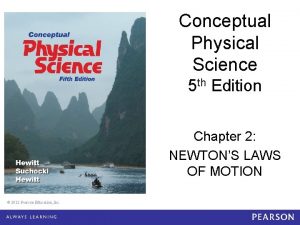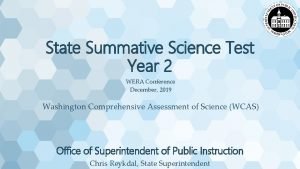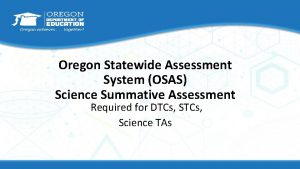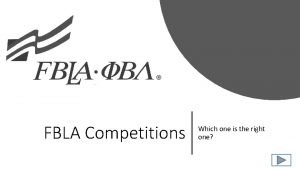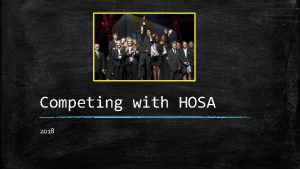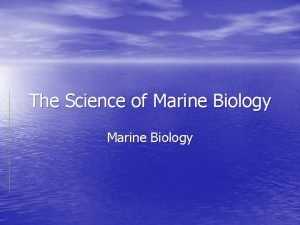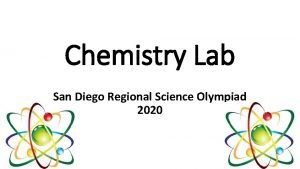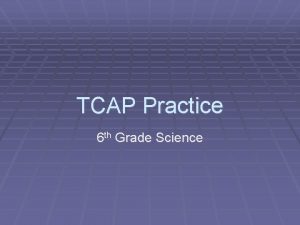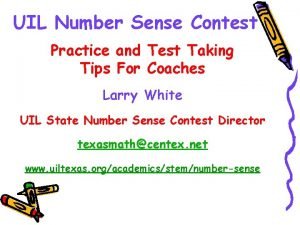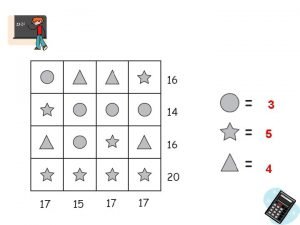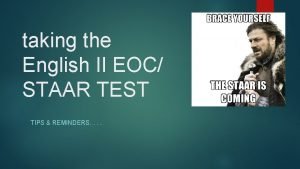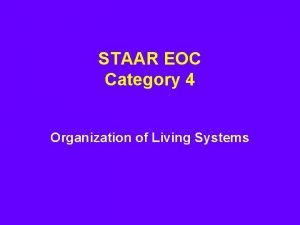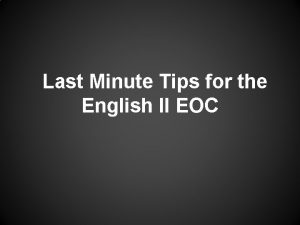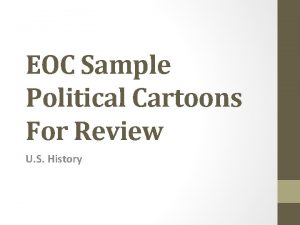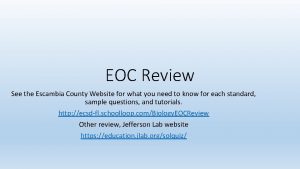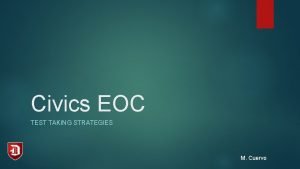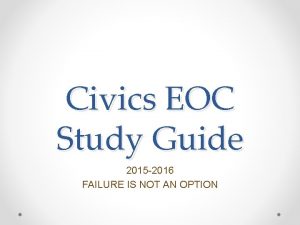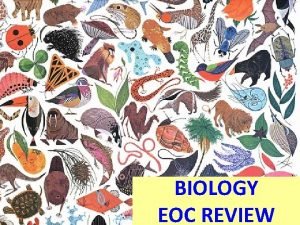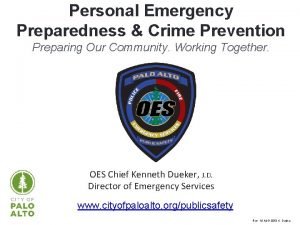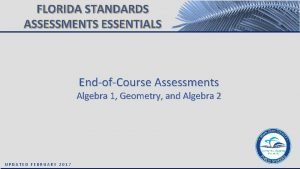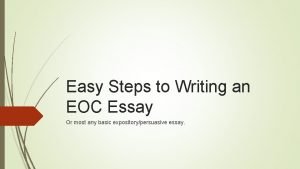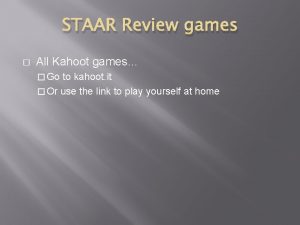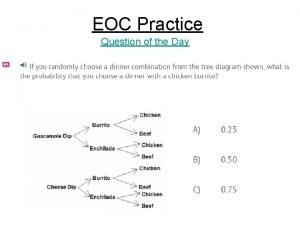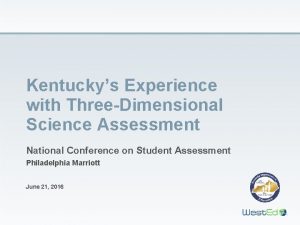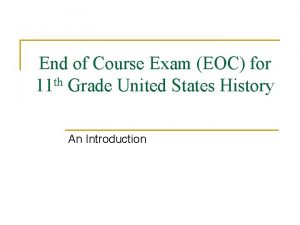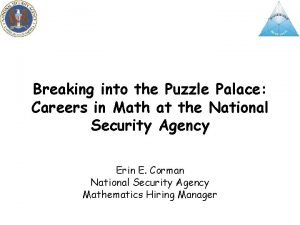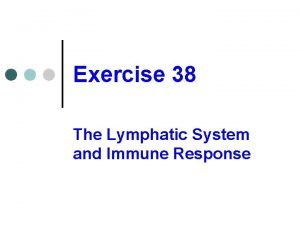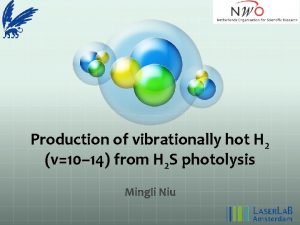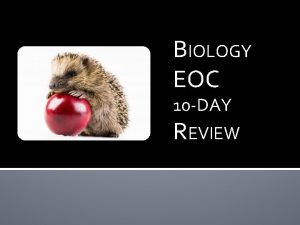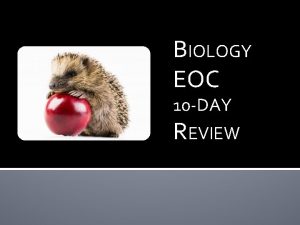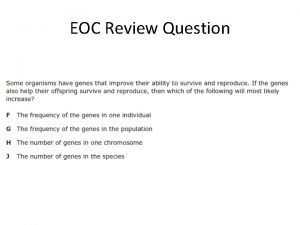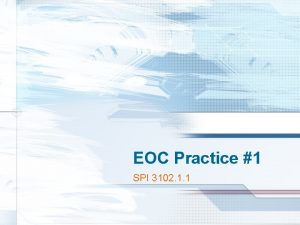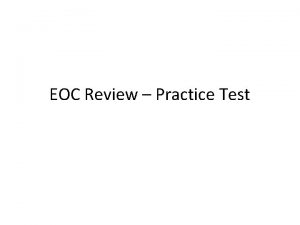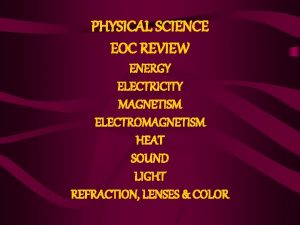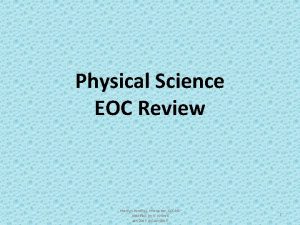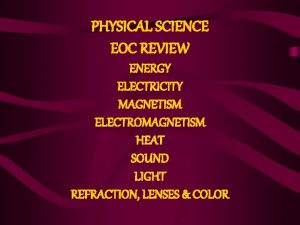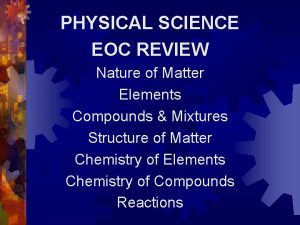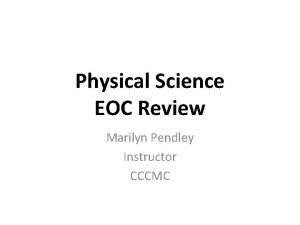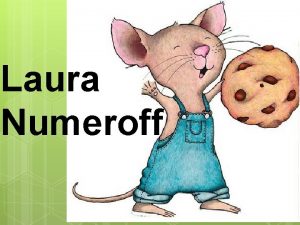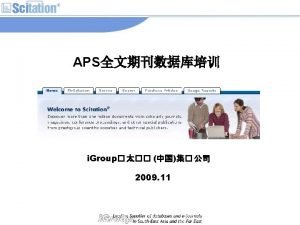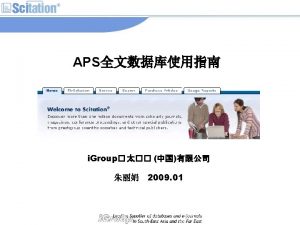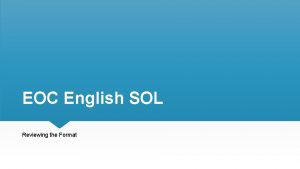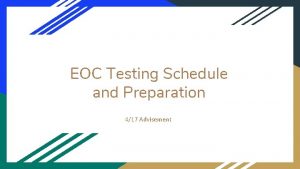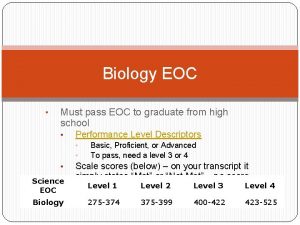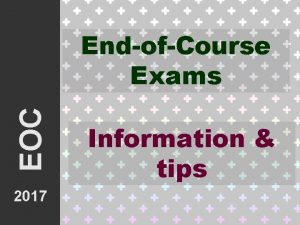PHYSICAL SCIENCE EOC REVIEW PRACTICE TEST 2 Laura















































































- Slides: 79

PHYSICAL SCIENCE EOC REVIEW PRACTICE TEST 2 Laura Rush Green Hope High School lrush 1@wcpss. net

EOC REVIEW ENERGY • Light energy can be concentrated in special light beams called A. masers B. rays C. lasers D. burning rays • ANSWER: C

EOC REVIEW ENERGY • When an atomic bomb explodes, the total amount of matter and energy involved in the change A. increases B. decreases C. remains the same D. cannot be predicted • ANSWER: C

EOC REVIEW ENERGY • A. B. C. D. In an energy transformation some energy is destroyed some energy is created energy is changed to matter no energy is lost • ANSWER: D

EOC REVIEW ELECTRICAL ENERGY • When the number of electrons and protons in a sample of matter are equal, the matter is A. neutral B. positively charged C. negatively charged D. insulated • ANSWER: A

EOC REVIEW ELECTRICAL ENERGY • Rubbing one substance against another causes A. nothing to happen B. a loss of protons C. a transfer of electrons D. a gain of protons • ANSWER: C

EOC REVIEW ELECTRICAL ENERGY • Two positively charged pith balls, brought close together, A. have no effect on each other B. repel each other C. attract each other D. first repel and then attract each other • ANSWER: B

EOC REVIEW MAGNETISM • An instrument currently used for navigation that operates on the principle of magnetism is a A. map B. lodestone C. compass • ANSWER: C

EOC REVIEW MAGNETISM • The theory that the Earth is a giant magnet was proposed by A. Gilbert B. Maxwell C. Ampere D. Oersted • ANSWER: A

EOC REVIEW MAGNETISM • To find the magnetic north pole of the Earth, scientists use an instrument known as a A. compass B. dipping needle C. lodestone D. sextant • ANSWER: B

EOC REVIEW ELECTRICITY & MAGNETISM • To determine which end of an electromagnet is the north pole, we can use A. a piece of steel B. tacks C. the left-hand rule D. the right-hand rule • ANSWER: C

EOC REVIEW ELECTRICITY & MAGNETISM • A decrease in the amount of current supplied to an electromagnet causes the strength of the electromagnet to A. increase B. decrease C. remain the same D. first decrease, then increase • ANSWER: B

EOC REVIEW ELECTRICITY & MAGNETISM • When the number of turns of wire around the core of an electromagnet is increased, the strength of the electromagnet A. increases B. decrease C. remain the same D. first decrease, then increase • ANSWER: A

EOC REVIEW HEAT ENERGY • The freezing point of water in the absolute temperature scale is A. 273 o. K B. 273 o. C C. 273 o. F D. 0 o. C • ANSWER: A

EOC REVIEW HEAT ENERGY • When objects are at different temperatures, A. heat is not transferred B. heat is transferred from the cooler object to the warmer object C. heat is transferred from the warmer object to the cooler object • ANSWER: C

EOC REVIEW HEAT ENERGY • Of the following, the best conductor of heat is A. nickel B. copper C. brass D. aluminum • ANSWER: B

EOC REVIEW SOUND ENERGY • Of the following, the device used to detect underwater objects is A. laser B. radar C. maser D. sonar • ANSWER: D

EOC REVIEW SOUND ENERGY • Of the following, sound is most closely associated with A. mechanical energy B. chemical energy C. heat energy D. potential energy • ANSWER: A

EOC REVIEW SOUND ENERGY • Matter that transmits sound possesses the property of A. flexibility B. elasticity C. permeability D. ductility • ANSWER: B

EOC REVIEW LIGHT ENERGY • The scientist who first measured the speed of light was A. Huygens B. Planck C. Maxwell D. Roemer • ANSWER: D

EOC REVIEW LIGHT ENERGY • The speed of light is approximately A. 1800 feet per second B. 300, 000 kilometer per second C. 18, 600 miles per second D. 350 meters per second • ANSWER: B

EOC REVIEW LIGHT ENERGY • The darker inner part of a shadow is known as the A. umbra B. crest C. penumbra D. trough • ANSWER: A

EOC REVIEW REFRACTION, LENSES & COLOR • The bending of light is known as A. reflection B. refraction C. diffraction D. dispersion • ANSWER: B

EOC REVIEW REFRACTION, LENSES & COLOR • When a ruler is placed in water at an oblique angle, besides appearing bent, the rule appears to be A. curved B. smaller C. magnified D. unaffected • ANSWER: C

EOC REVIEW REFRACTION, LENSES & COLOR • When light enters a medium such as water or glass from the air, its speed A. decreases B. increases C. remains the same D. increases, then decreases • ANSWER: A

PHYSICAL SCIENCE EOC REVIEW Metallic Properties Solutions Suspensions & Emulsions Properties of Water Acids, Bases, and Salts Organic Chemistry Laura Rush Green Hope High School lrush 1@wcpss. net

EOC REVIEW METALLIC COMPOUNDS • A. B. C. D. Of the following, the one that is not an agent of corrosion is water chromium oxygen sulfur dioxide • ANSWER: B

EOC REVIEW METALLIC COMPOUNDS • A. B. C. D. In the process of galvanizing, iron is coated with tin lead copper zinc • ANSWER: D

EOC REVIEW METALLIC COMPOUNDS • A. B. C. D. Of the following, the covering that does not prevent corrosion is water oil grease paint • ANSWER: A

EOC REVIEW SOLUTIONS • A. B. C. D. When salt dissolves in water, equal portions of this mixture contain the same quantities of solid and liquid. Such a mixture is said to be unstable saturated uniform a tincture • ANSWER: C

EOC REVIEW SOLUTIONS • A. B. C. D. In a solution, the dissolved substance is called solute solvent tincture distilled • ANSWER: A

EOC REVIEW SOLUTIONS • A. B. C. D. The liquid referred to as the “universal solvent” is benzene oil alcohol water • ANSWER: D

EOC REVIEW SUSPENSIONS/EMULSIONS • A. B. C. D. Brownian motion describes the movement of atoms particles in a suspension colloidal particles coagulated particles • ANSWER: C

EOC REVIEW SUSPENSIONS/EMULSIONS • A. B. C. D. Of the following, the substance with the smallest particles is clay sand gravel pebbles • ANSWER: A

EOC REVIEW SUSPENSIONS/EMULSIONS • A. B. C. D. The particles of a solution absorbs all light do not affect light reflect light are opaque to light • ANSWER: B

EOC REVIEW PROPERTIES OF WATER • A. B. C. D. The best procedure to separate a mixture of iron filings and sulfur is to filter the mixture coagulate the mixture use a magnet centrifuge the mixture • ANSWER: C

EOC REVIEW PROPERTIES OF WATER • A. B. C. D. At the boiling point of a liquid, if heat continues to be applied, the temperature of the liquid continues to increase remains the same begins to decreases a little and then increases again • ANSWER: B

EOC REVIEW PROPERTIES OF WATER • A. B. C. D. Generally, the boiling point of water at sea level is 100 degrees Celsius 100 degrees Fahrenheit 202 degrees Celsius 32 degrees Fahrenheit • ANSWER: A

EOC REVIEW ACIDS, BASES, SALTS • A. B. C. D. Of the following, the salt that is used to make photographic film is Na. Cl Ca(NO 3)2 K 2 SO 4 Ag. Br • ANSWER: D

EOC REVIEW ACIDS, BASES, SALTS • A. B. C. D. A salt used as the electrolyte in dry cells is ammonium carbonate ammonium chloride silver nitrate sodium sulfate • ANSWER: B

EOC REVIEW ACIDS, BASES, SALTS • A. B. C. D. When water solutions of an acid and a base are mixed, no reaction occurs a new acid and a new base are formed a salt and water are formed an acid and a salt are formed • ANSWER: C

EOC REVIEW ORGANIC CHEMISTRY • A. B. C. D. The major component in organic compounds is the element oxygen carbon hydrogen chlorine • ANSWER: B

EOC REVIEW ORGANIC CHEMISTRY • A. B. C. D. One product of the burning of wood is petroleum cellulose water oxygen • ANSWER: C

EOC REVIEW ORGANIC CHEMISTRY • A. B. C. D. The substance with the lowest melting point is Na. Cl Si. O 2 Na. OH paraffin • ANSWER: D

EOC REVIEW NATURE OF MATTER • Which of the following is not a necessary characteristic of a chemical change? • A a change in composition • B release of energy • C absorption of energy • D a change in state • ANSWER: D

PHYSICAL SCIENCE EOC REVIEW Nature of Matter Elements Compounds & Mixtures Structure of Matter Chemistry of Elements Chemistry of Compounds Reactions Laura Rush Green Hope High School lrush 1@wcpss. net

EOC REVIEW NATURE OF MATTER • Changes that continue unaided are said to be • A consistent • B spontaneous • C reversible • D models • ANSWER: B

EOC REVIEW NATURE OF MATTER • A substance that increases the rate of a reaction is • A solid • B liquid • C gas • D catalyst • ANSWER: D

EOC REVIEW COMPOSITION OF MATTER • When lead oxide is heated in a test tube, the walls of the tube become coated with • A hydrogen • B oxygen • C lead • D silver • ANSWER: C

EOC REVIEW COMPOSITION OF MATTER • Substances that cannot be decomposed to any simpler substances are called • A elements • B compounds • C mixtures • D none of these • ANSWER: A

EOC REVIEW COMPOSITION OF MATTER • • • The element needed to sustain life is A iron B oxygen C hydrogen D water • ANSWER: B

EOC REVIEW CHEMISTRY OF ELEMENTS • • • When metals react chemically, they A gain electrons B lose electrons C gain protons D lose protons • ANSWER: B

EOC REVIEW CHEMISTRY OF ELEMENTS • When elements with four electrons in their outermost level react chemically, they • A always gain 4 electrons • B always lose 4 electrons • C may lose, gain, or share 4 electrons • D may lose or gain 4 electrons • ANSWER: C

EOC REVIEW CHEMISTRY OF ELEMENTS • As we move from left to right across a period in the Periodic Table, metallic activity • A decreases • B increases • C remains the same • D increases, then decreases • ANSWER: A

EOC REVIEW CHEMISTRY OF ELEMENTS • In the Periodic Table, the elements that exhibits the strongest nonmetallic properties is found • A on the upper left side • B on the lower left side • C on the upper right side • D on the lower right side • ANSWER: C

EOC REVIEW CHEMISTRY OF ELEMENTS • In the outermost electron level of most metalloids, the number of electrons is • A 8 • B 4 • C 2 • D 6 • ANSWER: B

EOC REVIEW CHEMISTRY OF ELEMENTS • In any group of metals in the Periodic Table, the most active metal in the group is found • A at the top • B in the middle • C at the bottom • D in different places depending on the group • ANSWER: C

EOC REVIEW CHEMISTRY OF COMPOUNDS • The total atomic mass of an element in a compound is 12. The formula mass of the compound is 100. The percentage composition of the element in the compound is • • A B C D 12% 88% 0. 12% 1. 2% • ANSWER: A

EOC REVIEW CHEMISTRY OF COMPOUNDS • The formula H 2 O 2 represents the compound • A water • B hydrogen peroxide • C hydrogen monoxide • D hydrogen dioxide • ANSWER: B

EOC REVIEW CHEMISTRY OF COMPOUNDS • When an atom of aluminum with a valence of +3 unites to form a compound, it • A donates 3 electrons • B accepts 3 electrons • C donates 5 electrons • D accepts 5 electrons • ANSWER: A

EOC REVIEW REACTIONS • The law of conservation of matter was first suggested by • A Dalton • B Lavoisier • C Democritus • D Rutherford • ANSWER: B

EOC REVIEW REACTIONS • Of the following words, the one used to represent a chemical reaction is • A an atom • B a formula • C an equation • D a symbol • ANSWER: C

EOC REVIEW REACTIONS • • • A chemical equation describes A only the reactants B only the products C neither the reactants nor the products D both the reactants and the products • ANSWER: D

PHYSICAL SCIENCE EOC REVIEW NUCLEAR FORCES & MOTION WORK & POWER FLUID FORCES MACHINES Laura Rush Green Hope High School lrush 1@wcpss. net

EOC REVIEW NUCLEAR ENERGY • Of the following, the radioisotope used to treat a thyroid gland is A. cobalt-60 B. carbon-14 C. iodine-131 D. phosphorus-32 • ANSWER: C

EOC REVIEW NUCLEAR ENERGY • Changes in heredity that may be produced by radiation are called A. transformations B. chemical changes C. mutations D. physical changes • ANSWER: C

EOC REVIEW NUCLEAR ENERGY • A device to track and study radioactive particles is A. an electroscope B. a cyclotron C. a Geiger counter D. a cloud chamber • ANSWER: D

EOC REVIEW FORCES • A push or pull exerted on an object is known as A. energy B. force C. charge D. magnetism • ANSWER: B

EOC REVIEW FORCES • Of the following, the example that does not create a force is A. magnetism B. gravity C. electrical charges D. velocity • ANSWER: D

EOC REVIEW FORCES • When several forces act on an object and the object does not move, the forces are said to be A. balanced B. unbalanced C. stable D. unstable • ANSWER: A

EOC REVIEW WORK & MACHINES • The ideal mechanical advantage of a pulley system can be found from the formula A. DR/DE B. E/R C. R/DE D. DE/DR • ANSWER: D

EOC REVIEW WORK & MACHINES • A simple machine used in a steering wheel and a bicycle is a A. lever B. wedge C. pulley D. wheel-and-axle • ANSWER: D

EOC REVIEW WORK & MACHINES • A. B. C. D. The ideal mechanical advantage of a wheel-and-axle equals the radius of the larger wheel divided by the radius of the axle divided by the radius of the wheel the effort divided by the resistance the effort distance multiplied by the resistance distance • ANSWER: A

EOC REVIEW FLUID FORCES • The term fluid applies A. only to liquids B. only to gases C. only to solids D. to liquids and gases • ANSWER: D

EOC REVIEW FLUID FORCES • Density is determined by the formula A. m/v B. v/m C. v x v D. m + v • ANSWER: A

EOC REVIEW FLUID FORCES • In the English system of measurements, density is measured in A. pounds per square inch B. pounds per cubic foot C. grams per cubic centimeter D. grams per cubic foot • ANSWER: B

EOC REVIEW FORCES & MOTION • The motion of a jet aircraft is primarily based on the law of A. action and reaction B. inertia C. momentum D. conservation of energy • ANSWER: A

EOC REVIEW FORCES & MOTION • When tow bowling balls simultaneously roll into a row of bowling balls that are at rest A. the last ball moves out of the row B. two balls move out of the row C. no change is observed D. all the balls are set in motion • ANSWER: B

EOC REVIEW FORCES & MOTION • An inward force created by uniform circular motion is called A. a buoyant force B. centrifugal reaction C. centripetal force D. gravity • ANSWER: C
 Physical science eoc review
Physical science eoc review Physical science eoc review
Physical science eoc review Hbs final exam practice test
Hbs final exam practice test Civics eoc practice
Civics eoc practice Florida us history eoc review
Florida us history eoc review Pbs eoc review
Pbs eoc review Gilded age eoc blitz review
Gilded age eoc blitz review Us history eoc review notebook
Us history eoc review notebook These were assaults ordered by attorney general mitchell
These were assaults ordered by attorney general mitchell 11 grade us history eoc review
11 grade us history eoc review The teapot dome scandal centered around *
The teapot dome scandal centered around * Civics 360
Civics 360 English eoc review
English eoc review Civics eoc review
Civics eoc review Biology eoc review georgia
Biology eoc review georgia Biology 10-day eoc review
Biology 10-day eoc review Us history
Us history Day 1 us history eoc review
Day 1 us history eoc review Us history eoc review the great depression and the new deal
Us history eoc review the great depression and the new deal Gilded age eoc blitz review
Gilded age eoc blitz review Day 8 us history eoc review
Day 8 us history eoc review Practice test 1 science reasoning test
Practice test 1 science reasoning test Eoc biology test
Eoc biology test Eoc test missouri
Eoc test missouri Describe a laura y a elián usando los verbos recíprocos.
Describe a laura y a elián usando los verbos recíprocos. Physrt
Physrt Chapter 4 work and energy section 1 work and machines
Chapter 4 work and energy section 1 work and machines Physical science chapter 14 test
Physical science chapter 14 test Chapter 15 review physical science
Chapter 15 review physical science Chapter 4 review physical science
Chapter 4 review physical science Chapter 14 review physical science
Chapter 14 review physical science Noah carried a skateboard
Noah carried a skateboard Chapter 5 review physical science
Chapter 5 review physical science As your room gets messier day by day, entropy is
As your room gets messier day by day, entropy is Chapter 16 review physical science
Chapter 16 review physical science Conceptual physical science practice sheet chapter 2
Conceptual physical science practice sheet chapter 2 Mind map of branches of science
Mind map of branches of science Natural science vs physical science
Natural science vs physical science My favorite subject is...
My favorite subject is... Wcas science practice test
Wcas science practice test Science olympiad ornithology practice test
Science olympiad ornithology practice test Osas tam
Osas tam How do fbla competitions work
How do fbla competitions work Hosa biomedical laboratory science practice test
Hosa biomedical laboratory science practice test Marine science chapter 1
Marine science chapter 1 Science olympiad san diego
Science olympiad san diego Tcap practice test 6th grade science
Tcap practice test 6th grade science Math uil practice tests
Math uil practice tests Uil math test
Uil math test Unit test unit test review algebra 2
Unit test unit test review algebra 2 No reason to lol staar answer key
No reason to lol staar answer key Peripheral nervous system consists of
Peripheral nervous system consists of English eoc tips
English eoc tips Eoc a sample
Eoc a sample Escambia biology
Escambia biology What is an elegy in literature
What is an elegy in literature In a normal operations/steady state eoc activation level
In a normal operations/steady state eoc activation level Civics 360.org
Civics 360.org Civics eoc study guide
Civics eoc study guide Georgia biology eoc
Georgia biology eoc Medford knives eoc
Medford knives eoc Algebra 1 reference sheet
Algebra 1 reference sheet Eoc
Eoc Whats an eoc
Whats an eoc Us history staar review kahoot
Us history staar review kahoot Humble isd graduation 2022
Humble isd graduation 2022 Gse geometry
Gse geometry Kentucky assessments eoc
Kentucky assessments eoc Eoc
Eoc Eoc
Eoc Nsa math proficiency test
Nsa math proficiency test Chapter review motion part a vocabulary review answer key
Chapter review motion part a vocabulary review answer key Ap gov final review
Ap gov final review Narrative review vs systematic review
Narrative review vs systematic review Narrative review vs systematic review
Narrative review vs systematic review Narrative review vs systematic review
Narrative review vs systematic review World history semester 2 exam review
World history semester 2 exam review Exercise 38
Exercise 38 Myeplg website
Myeplg website Physical review a
Physical review a
